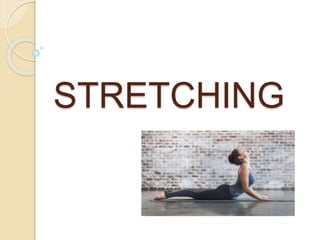
STRETCHING.pptx
- 1. STRETCHING
- 2. INTRODUCTION: Stretching is a general term used to describe any therapeutic maneuver designed to increase the extensibility of soft tissues, thereby improving flexibility by elongating (lengthening) structures that have adaptively shortened and have become hypomobile over time.
- 3. STRETCH REFLEX: The stretch reflex (myotatic reflex), or more accurately "muscle stretch reflex", is a muscle contraction in response to stretching within the muscle.
- 4. RECIPROCAL INHIBITION: Reciprocal inhibition describes the relaxation of muscles on one side of a joint to accommodate contraction on the other side.
- 5. AUTOGENIC INHIBITION: When the GTO inhibits the (agonist) muscle's contraction and allows the antagonist muscle to contract more readily, the muscle can be stretched further and easier.
- 6. INDICATION FOR STRETCHING: ROM is limited because soft tissues have lost their extensibility as the result of adhesions, contractures, and scar tissue formation causing functional limitations or disabilities. May be used as part of a total fitness program designed to prevent musculoskeletal injuries. May be used prior to and after vigorous exercise potentially to minimize post exercise muscle soreness.
- 7. CONTRAINDICATIONS FOR STRETCHING: Recent fracture Hematoma or other tissue trauma There is a evidence of acute inflammatory or infectious process Hypermobility already exist
- 8. PRINCIPLE OF STRETCHING: 1. Alignment 2. Stabilization 3. Intensity of stretch 4. Duration of stretch 5. Speed of stretch 6. Frequency of stretch 7. Mode of stretch
- 9. 1. Alignment Proper alignment or positioning of the patient and the specific muscles and joints to be stretched is necessary for patient comfort and stability during stretching • For example, To stretch the rectus femoris ( crosses two joints) effectively, as the knee is flexed and the hip extended, the lumbar spine and pelvis should be aligned in a neutral position. The pelvis should not tilt anteriorly nor should the low back hyperextend; the hip should not abduct or remain flexed.
- 10. 2. Stabilization To achieve an effective stretch of a specific muscle or muscle group and associated periarticular structures, it is necessory to stabilize (fixate) either the proximal or distal attachment site of the muscle-tendon unit being elongated. For example, when stretching the iliopsoas, the pelvis and lumbar spine must maintain a neutral position as the hip is extended to avoid stress to the low back region.
- 11. 3. Intensity of stretch: The intensity (magnitude) of a stretch force is determined by the load placed on soft tissue to elongate it. Low-intensity stretching has also been shown to elongate dense connective tissue, a significant component of chronic contractures, more effectively and with less soft tissue damage and post-exercise soreness than a high- intensity stretch.
- 12. 4.Duration of stretch: In general, the shorter the duration of a single stretch cycle, the greater the number of repetitions applied during a stretching session. In a study by Cipriani et al., two repetitions of 30-second hamstring stretches were found to be equally effective compared to six repetitions of 10-second stretches.
- 13. TYPES OF STRETCHING: 1. Static stretching 2. Cyclic stretching 3. Ballistic stretching 4. PNF stretching 5. Manual stretching 6. Mechanical stretching 7. Self stretching 8. Active stretching
- 14. PRECAUTIONS FOR STRETCHING: Don’t passively force beyond its normal ROM. Avoid vigorous stretching of muscles and connective tissues that have been immobilized for an extended period of time. Avoid stretching edematous tissue, as it is more susceptible to injury than normal tissue.